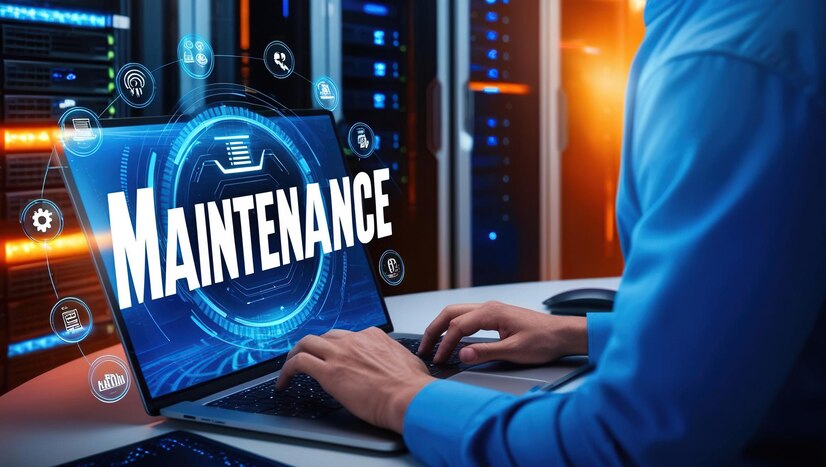Information technology (IT) has changed the way we interact with other people, do business, and plan for the future. It is possible to change society in a way that has never been seen before by making innovation and connectivity the very essence of information technology. Today’s modern economies use Information Technology to facilitate economic growth, enhance digital development, optimize operations, and boost productivity levels.
In the Middle East and North Africa (MENA) region, Information Technology is critical for achieving economic diversification, enhancing government efficiency and global competitiveness. It is not merely a tool that comes in handy. Information technology has also been used to support major development initiatives, including the UAE's Smart Dubai Initiative and Saudi Arabia's Vision 2030, underscoring the importance of reform.
Information technology in MENA continues to develop rapidly. According to an IDC report, IT spending in the Middle East is projected to reach $23 billion by 2025. There will be significant investments in IoT, AI, and cloud computing, among other areas. These highlights clearly demonstrate the region’s increasing appetite for advanced Information Technology IT solutions as both businesses and governments realize the importance of availing IT solutions for driving innovation and ensuring sustainability.
UAE Prime Minister and Vice President Sheikh Mohammed bin Rashid Al Maktoum once expressed that, ‘Innovation is the capital of the future, and technology is its investment’ quite profoundly. This inspirational quote clearly emphasizes the capability of Information Technology and how it can change the face of any industry and also the prospects for development.
What is Information Technology?
The phrase information technology IT refers to the interactive activity interconnected hardware, networks, and software for the purpose of information. Browsers such as Google, Snapchat, and Uber are the driving forces of automation, data analysis, and electronic communications, all of which are necessities in today’s world. One cannot overstate the role of information technology in all spheres of life from enhancing the ordinary chores to changing global industries.
Furthermore, Considering the MENA region, the importance of Information Technology is really high as the major contributor to the development. Smart Dubai defines IT as "the way of unlocking creativity and a pathway to a digitally connected world" as one of the Emirates major digital transformation programs. A very well defined intermediary term that indicates how the role of information technology affects business and social development especially in countries and regions that are vying for digital dominance.
Key Components of Information Technology
Information Technology and its major elements are what define technological structures, the same elements that notably powers the worth and usage of this innovation. Any tools and solutions that encourage businesses to grow, enhance their communication and contribute to the economic development — especially in the rapidly growing MENA region — require such components for information technology.
Hardware: The Physical Foundation
Information Technology hardware includes physical parts such as high-end servers, general-use computers and complex networking equipment, such as edge devices. Experts predict that investments in hardware in the MENA region will increase by 8 % per year due to the widespread use of IoT devices and edge computing. For instance, the advanced hardware network enables the realization of the smart-city vision of Neom City in the Kingdom of Saudi Arabia.
Software: The Automation Catalyst
Software constitutes the core element of any sector and Information Technology in this case. This includes operating systems, enterprise resource planning (ERP) systems, and AI applications that enhance efficiency and facilitate the automation of processes. This aspect shows how useful IT is to businesses in the MENA region in terms of reducing costs and enhancing output. By developing AI based software, G42 which is an Information Technology firm based in UAE has transformed industries such as health, security, and energy.
Networks: Facilitating Seamless Connection
What is communication in Information Technology Without strong networks? To mention but a few, systems like Local Area networks, Wide Area Networks or even 5G technologies are integral tools to Information Technology due to the fact that they provide means of communication and data exchange. According to Etisalat, MENA is at the forefront of introducing the 5G technology with a 95% penetration for mobile broadband in the United Arab Emirates. Such connectivity builds a foundation for intelligent companies and state-driven initiatives like Dubai Internet city, that positions the region as a center for global innovation.
Data: MENA Region’s New Oil
The New Oil is Data. In today’s world, Data is one of the most refined tools in Information Technology, and also sometimes referred to as ‘the new oil’. Also, with the application of Information Technology such as Marketing Predicting, customer relationship management, as well as predictive analytic, comes the collection, storage, and analysis of data which insightfully makes these applications possible. It is expected that in 2026, businesses in Mena regions will reach spending of $3.9 billion in regards with Data Analytics Solutions Gartner which further emphasizes the importance to the economic success that excelled through innovation, ingenuity, and invention.
People: The Human Factor in the Success of Information Technology
Technology is unable to function independently; it is skilled practitioners of Information Technology who oversee the appropriate design, development, and protection of systems. From the Saudi context, this significantly underlines the existing role IT professionals possess, as they play an integral part in closing the gap between idea and implementation. Countries such as Egypt and Jordan have developed a sizable talent pool in Information Technology which has made them significant providers of skilled professionals on a global scale.
Types of Information Technology in MENA
The MENA region is indeed adopting technology at an alarming pace, and this adoption is influenced by the type of information technology leveraged on a specific problem or a groundbreaking opportunity. IT plays a central role in the advancement of the region such as enabling the smart cities revolution or even expanding sectors such as oil and gas. The following types of Information Technology which seem to affect the MENA region the most are presented below, again, with supporting statistics, case studies and great leadership.
Enterprise IT: The Backbone of Regional Industries
This region is characterized by the need for enterprise Information Technology in retail, finance and oil & gas business. Businesses are able to create greater efficiencies and enhance such activities as processes by using Enterprise Resource Planning (ERP) and Customer Relationship Management (CRM) solutions. Taking Aramco for example, one of the largest oil companies in the world, it has implemented state-of-the-art ERP systems to improve its supply chain as well as its decision making processes.
As predicted by the International Data Corporation (IDC), investment in Information Technologies in the region is estimated to exceed 7.5 billion dollars in 2024 for the targeted large-scale digital transformation initiatives underscoring the role of IT in business processes.
Cloud Computing: Empowering Scalability and Innovation
The adoption of Cloud Computing services has increased in the UAE and Saudi Arabia who are leading the MENA region in the use of clouds. For instance, the UAE has implemented Microsoft Azure and Amazon Web Services (AWS) for use in the public as well as the private sectors.
Cloud solutions form the bedrock of Saudi’s Vision 2030, and the government’s spending on cloud computing is expected to grow by 15% annually. These platforms enable businesses to grow quickly, acquire a huge volume of information, and lower the expenses for operations.
Artificial Intelligence (AI): The Future of IT in MENA
In this case, it would be easy for a motion to point out that information technology is a field in which any man cannot really succeed , but it would definitely be beyond arguments that the intersection of technology with artificial intelligence is simply magical. No wonder then, governments throughout MENA have put forth plans to integrate artificial intelligence into their technologies, education and healthcare access. For instance, Sidra Medicine in Qatar incorporates AI algorithms to enhance patient care and provide a correct diagnosis.
As per PwC, businesses and governments have prioritized AI integration as it has the potential to increase the MENA economy by a staggering $320 billion by 2030. Dubai’s Crown Prince, Sheikh Hamdan bin Mohammed once stated, “AI will define the future of our cities and economies. We must be pioneers in adopting and utilizing this transformative technology.”
IoT (Internet of Things): Enabling Smarter Cities
The most significant component in developing an up-to-date and smart urban administration as well as an up-to-date city management, planning and development is the introduction of IoT (Internet of Things), which has already been adopted into various projects throughout MENA countries. Major Information Technology-driven projects, such as King Abdullah Financial District in Riyadh and Smart City Dubai, fully utilize IoT to integrate energy usage, traffic, and waste management.
Analysts suggest that, by 2025, the IoT market will reach over $10 billion and that the UAE is likely to spearhead the deployment of IoT devices in the region. Besides, the application of information technology in manufacturing and agriculture are also changing the way automation and real-time processing are done, and therefore extends beyond the cities.
A Region Poised for Information Technology Excellence
An area ready for Information Technology greatness when the MENA’s society, primary productive sector, and military systems employ these types of information technology, demonstrates how much it matters. MENA is investing in Information Technology for growth and modernization, from AI for more sound decision making to IoT for connected living to cloud computing for innovating to enterprise Information Technology for operational effectiveness. As Khaldoon Al Mubarak, the CEO of Mubadala said: “Technology is the enabler of change and the driver of progress. In the MENA region, it is the bridge to a sustainable, prosperous future.”
By employing the aforementioned strategies, it is evident that Mena has grasped the basic components of information technology and in particular, its practitioners have continued the trend of accelerating information age transformation with MENA region Information Technology companies being essential in positioning the area towards an innovative, connected and digital age.
Importance of Information Technology in the MENA Region
Information Technology in the MENA region facilitates technological advancement, societal transformation and economic growth. It is a cross-cutting tool that transcends industries -- linking traditional practices with evolved visions. Information Technology is the major enabler of change within the region that ranges from enhancing connectivity to business diversification. Hereunder, we analyze the importance of information technology with the compelling statistics and insights from leading projects in the region.
Economic Diversification: Building Resilient Economies
As MENA countries begin to wean themselves off the oil regime, information technology stands out as a key tool of economically diversifying. Such initiatives as Vision 2030 for Saudi Arabia also stress the need to deploy Information Technology in non-oil sectors such as fintech, healthcare and tourism. Fintech, cloud computing and AI based systems have the potential of enhancing productivity and simplifying the processes which these sectors facilitate.
PwC Middle East estimates that by the year 2030 the digital economy in the region will be worth US $400 billion with Information Technology for business being instrumental in this. For example, there is a strong growth in IT for Business in Saudi Arabia which is attributable to investment in IT infrastructure that has led to e-commerce growing in excess of 28 percent every year. In the words of Crown Prince Mohammed bin Salman:
“Technology is not just a tool; it is the foundation upon which we build our future economy.”
Enhancing Connectivity: The Power of Communication
What is communication in Information Technology? It’s the ability to link people, objects, and services effortlessly thereby making a difference in lifestyles and industries. Faster transfer of data, collaboration at the time of need, and technological advancements in sectors such as e-commerce, telemedicine, and logistics are all facilitated by the introduction of 5G technology across the MENA region.
The United Arab Emirates is on pace to be at the forefront of Information Technology applications in the area with several leading smart city initiatives such as Etisalat’s 5G coverage expansion that provides an underlying basis for further development. Likewise Ooredoo in Qatar is improving the communication infrastructure using Information Technology, which in turn allows for innovation on IoT and AI based technologies. 5g adoption in the region is predicted to reach 60% penetration by 2026 thus providing connectivity infrastructure at a global scale.
Social Development: Transforming Lives Through IT
Information Technology is often only considered an essential part of commercialization; however, that is no longer the case. Through tools such as Egypt’s Knowledge bank, which allows millions of students’ access to vast digital libraries, barriers to education have all but vanished. In a similar vein, Information Technology based telemedicine is changing the landscape in medicine, in the UAE and Qatar, by enabling consulting and diagnostics sessions over distances.
The Arab ICT Organization estimates that over 50 million people in the region are now able to use services and systems that enable them to receive medical assistance. Such an impact was noted by Dr. Ali Al Kuwari, Minister of Commerce and Industry of Qatar: “The future of our societies depends on how we integrate technology into education, healthcare, and social services. IT is the cornerstone of this transformation.” Understanding the importance of Information Technology is the basis of transformation.
MENA’s Information Technology as a Driver of Transformation
Countries in the Mena region are focusing on the transformational capacity presented by information technology, implementing modern technology to both enhance services offered to the public and optimize industries while improving the standard of living. Largening of MENA narrows the gaps in social development while MENA invests in the key components of Information Technology.
UAE: Leading with Visionary Digital Governance
Once again, the United Arab Emirates is at the forefront of digitalization with its ambitious Smart Dubai plan. By utilizing such cutting-edge types of information technology as AI, data analysis and even blockchain, demand for a Smart Dubai to become the first ever fully paperless government in history. This equates to a perfect case of how information technology has facilitated governance more so through digitization. The government of the United Arab Emirates claims that through transformation, operating expenses of Smart Dubai have been reduced by at least 1.3 billion AED, which is roughly 350 million dollars.
A few informative statements have been made by Sheikh Mohammed bin Rashid Al Maktoum, who is the current vice president as well as the prime minister of UAE, regarding the use of information technology in governance.
“Digital transformation is not an option; it is the key to sustainable economic growth and a better quality of life.”
The applications of Information technology are used for purposes other than governance. Dubai is a global pioneer in innovation because of the UAE's Information Technology companies, like Etisalat and du, who are leading the way in enabling 5G networks, IoT-based systems, and smart city infrastructure.
Saudi Arabia: Building the Future with NEOM
Another attempt at the MENA region using Information Technology to build the future is the Saudi city of NEOM. NEOM is the very epitome of an AI city in its design that merges technology with IoT and renewable energy to achieve urban sustainability. Urbanization, which is based on data analytics, networking, and technological innovation of self-driving vehicles, is the core foundation of NEOM’s ecosystem.
The NEOM's ecosystem exists to address the global needs of multinational Information Technology enterprises to foster innovation-driven economic growth, which clearly highlights the global importance of Information Technology for business. In excess of 500 billion dollars have been allocated for NEOM, thus signifying the Saudi government’s realization on the importance of advancing through Information Technology solutions. And it has been said by Crown Prince Mohammed bin Salman:
“NEOM will be a hub where technology and innovation converge to solve humanity’s challenges.”
Qatar: Advancing with National Vision 2030
As expressed in the Qatar National Vision Plan 2030, maximizing the role of information technology in realizing development is most pronounced. Investing over $1.5 Billion in a single year for the advancement of smart technology is leading to massive changes in certain industries such as healthcare, education, and transportation. Wearable technology and telehealth are but a few examples of applying smarter technologies within the healthcare sector for better efficiency and access.
Maximizing the role of information technology usage in the classroom also has its record. Digital platforms for engaging students with teachers and school administrators can be seen in operation through the Qatar Education Network, an example of collaboration communication in information technology Applications. The booming industry of e-commerce in Qatar which has grown about 35% per annum supported by versatile Information Technology infrastructure serves to show yet another dimension of the importance of information technology for business. As Jassim Saif Ahmed Al-Sulaiti, Minister of Transport and Communications for Qatar puts it, “Technology is the foundation for innovation and progress, enabling us to build a prosperous future for generations to come.”
The Intersection of Information Technology and Communication
One of the revolutionary influences of information technology is the ability to communicate in an integrated and fluid manner. This aspect which is very frequently discussed under the rubric of "what is communication in information technology?" has emerged as one of the components of hyper connectivity in the MENA region. The region is changing the way individuals, systems and businesses interact by integrating advanced types of information technology such as cloud services, 5G and Internet of Things. This is ushering in an age of instantaneous connections and innovation.
Redefining Connectivity with 5G and Beyond
The MENA region is witnessing a radical transformation in communication thanks to the 5G networks that have been set up over the past few years. The investment of the governments as well as the Information Technology companies in such an advanced infrastructure in the region has provided the businesses in the E-Commerce sector as well as in Telemedicine and smart city concepts with new opportunities that had not been available previously.
As an illustration, Dubai's Smart City strategy utilizes IoT devices that are connected to 5G networks to enable time-sensitive urban management skills such as efficient waste disposal and traffic regulation. Moreover, such technologies as driverless vehicles and AI-enhanced medical consultation are being developed and deployed in applications of information technology solutions powered by 5G technologies in Saudi Arabia. The GSMA Mobile Economy Report projects that by 2025, MENA super-exclusive adoption levels will touch 17%, stimulated by more than $50 billion worth of expenditures made on the digital infrastructural designs in the region.
Internet Penetration: A Game-Changer
The rising internet penetration in this region of the world certainly does show how much communication in information technology is fundamental to the overall foundation of IT within any information system. With more than 470 million mobile subscribers, the penetration rate for the internet in the MENA region is set to exceed 75% by 2023. This explosion opened up new frontiers in economic opportunities for information technology covering such areas as digital advertising, e-commerce, and fintech. Differently, countries like Qatar and Bahrain are transforming into an IT base for the region together with international Information Technology companies by developing advanced technology.
Communication’s Role in Transforming Industries
The field of information technology is pertinent to communication not only in the aspect of connectivity but also enhances creativity in diverse fields such as:
- Medical care: As influenced by IT-enabled communication facilities such as tele medicine platforms, Qatar is able to conduct real time consultative services which further underscores the importance of Information Technology in enhancing care for patients.
- Education: E-learning platforms in Egypt are basic in Information Technology, including essential components such as cloud computing and video conference enabling technology, for the integration of millions of students.
- E-commerce: The Online retail business in Saudi Arabia has grown by 35% every year, due to advances in Information Technology enabled communication and payment systems.
Expert Insights on IT and Communication in MENA
Communication and Information Technology Development in the region is rapidly transforming as modern experts and leaders consistently keep pointing out. The UAE’s Sheikh Mohammed bin Rashid Al Maktoum also stated “Information Technology is the backbone of modern communication, bridging distances and connecting people to opportunities.”
Moreover, the Arab ICT Organization mentioned that the communication related information technology such as 5G and AI would add $95 billion to the economy by 2030.
Stat Insight: Although over 470 Million mobile customers exist in the Mena region as per the 2023 statistics, there has been a steady surge in the internet penetration rate within the Mena region to over 75% clearly indicating the significance of the towers within the Ict infrastructure.
Information Technology’s Economic Role in MENA
As the Middle East and North African region proceeds to grow, so does the integration of Information Technology in other countries. The role of Information technology has greatly contributed to Iraq’s economic growth since it promotes accountability and a healthy competitive space. Although a few parts of Iraq, such as the private sector, have started the integration process, many areas still rely heavily on outdated technology. Such information technologies spanning from clouds to microchips allow consolidation of processes, boosting different aspects of the economy such as competition.
Cloud Computing: A Key Driver of Growth
In the MENA region, the use of cloud computing has allowed for a business-centric approach to the integration of information technology – this business approach has led to an incredible growth of 30% in the adoption of cloud technologies through 2022 and has helped companies further lower their operational costs, improve their level of scale and optimize the processes of work.
They are leveraging this trend, as big global companies such as Microsoft and Amazon Web Services (AWS) continue to expand their data center footprint in the region.
Analysts such as Gartner expect the MENA Information Technology market to witness growth with an impressive CAGR of 8.2% between the years 2023 to 2028, with the increasing requirement of smart and agile technology acting as one of the main factors. This is in line with country objectives of a digital economy transformation such as the Saudi Arabia Vision 2030 which aims to position the Kingdom as a global hub for key Information Technology aspects such as cloud computing and Artificial Intelligence AI analytics.
Digital Empowerment and Economic Inclusion
In addition to hardware and infrastructure, information technology is significant since it has the potential for empowering and fostering inclusion, for instance, In Egypt, e-commerce has increased by 8% each year due to platforms that enable businesses to enter the global market. Likewise, the technological projects pursued in Qatari industries like healthcare logistics have contributed to lowering disparities by promoting inclusiveness through innovation.
This larger picture is articulately emphasized by the Egypt’s Minister of International Cooperation, Rania Al-Mashat:
“Technology is not only about digitization but also about empowerment and inclusion. It drives sustainable development and fosters innovation across all sectors.”
Accelerating Enterprise Transformation
In the MENA region, the use of Information Technology in the business processes has caused the business models to transform to great extents. Firms are trying to thrive in this digital age incorporating technologies ranging from data analytics powered AI in Dubai to IoT based solutions in Oman, this makes Information Technologies a key component.
Financial Services: The remarkable innovations in Information Technologies has resulted into the big growth in the fintech sector of UAE which has now grown to 2 Billion Dollars in GDP with an annual growth of about twenty-five percent.
Retail: Applications of Information Technology for business are being increasingly adopted by the retail giants of Saudi Arabia, which has resulted in a growth of 35percent in online sales in the year 2023.
Information Technology’s Broader Impact on Society
The MENA region is increasingly grappling with pressing issues and looks up to information technology for assistance. There is more than an economic aspect of IT in the MENA region. Educational non-profit HDIC has, for example through Edraak, transformed the lives of many in Jordan and reached over 2 million users through e-learning platforms. AI based systems that aid in better management of water resources are also revolutionizing agriculture in Morocco, the country that has one of the least water resources in the world.
Building an inclusive society also necessitates revolution and the role of Information Technology remains important as it helps with reaching goals. Providing integrated societies that are equal and just involving everybody is where information technology can help like in the example of digital medical services in Qatar and the UAE becoming popular while telemedicine is still lacking.
In the innovation focus of MENA several sectors bear the greatest promise and Information Technology companies are actively developing them such as healthcare and finance. What the region needs is adequate conditions for an Information Technology boom with 470 million subscribers and internet users accounting for more than 75% and as Sheikh Mohammed bin Rashid Al Maktoum puts it, “Technology builds nations and empowers the people.”
The current trajectory of growth illustrates the reasons why various forms of Information Technology and their broad applicability serve to achieve regional aims. Showcasing creative thought and enabling such solutions as are most needed by society in the MENA region, Information Technology is not only shaping up the today but is nurturing the tomorrow as well.
Challenges of Information Technology in MENA
Though information technology has the potential to transform MENA, there are certain challenges that need to be addressed in policy in order promote growth.
Cybersecurity Risks
The increasing use of information technology makes the region a target for cyber attacks. Researchers show that in 2022, cyber-attacks affected 66% of MENA firms, resulting in billions of dollars worth of damages.
Solution: Governments are escalating the safeguarding of critical infrastructure and business operations by wresting control over cyberspace, as in the case of Saudi Arabia, which has set up a National Cyber Security Authority.
Connectivity Gaps
In rural areas, the absence of internet connection acts as a hindrance to the application of information technology, while in urban areas there is no such limitation as they are equipped with robust IT infrastructure.
Solution: Qatar makes an annual investment of over 1.5 billion dollars to enhance connectivity and establish a strong infrastructure in rural areas which includes satellite internet and 5G networks.
Skill Shortages
The shortfall of qualified information technology employees is one of the factors that inhibit the ability of IT to increase innovation. Reports such as this indicate that skill shortages hinder hiring of over 40% of the region’s IT enterprises.
Solution: To mitigate the skill gaps, measures such as Egypt’s Future Work is Digital program aim at equipping around 100,000 youth with advanced ICT skills to make sure that the labour market is able to meet the regional needs.
These challenges indicate the extent to which information technology is an industry that is in need of advancement as well as a center of solutions. By calibrating efforts and coming together, the MENA region has enough capabilities to harness Information Technology to mend fractures and advance in equitable growth. As highlighted by Sheikh Mohamed bin Zayed Al Nahyan, “Innovation is the engine of progress, and we must invest in the skills and tools to build a future-ready society.”
How Information Technology Companies are Shaping MENA
The increasing demand of global service transformation, propelled by Information Technology Companies has set the trajectory that MENA encompasses a vibrant economy. Information Technology for business expects the infrastructure expenditure on IT in the region to surpass $50 billion dollars by 2025 as there is a rapid demand for cloud computing, AI and IoT technologies. As evident from the expenditure, information technology plays an integral role in building smarter cities and achieving economic sustainability.
It's the top Information Technology companies which are effecting this change:
- SAP MENA is on the forefront in the adoption of information technology for digital transformation especially in the MENA region with respect to government and business.
- IBM MENA gives access to the cutting-edge AI and cloud platforms that help in improving the quality of decisions.
- Based in the UAE, Injazat is a leader in the market of IT-managed services and disposes of capabilities in furling UAE’s ambition in establishing as a global hub of digital deployment.
These companies are supporting regional efforts like the Digital Strategy 2030 for Dubai which aims at making the city the most intelligent city. As the Arab League has pointed out, “Technology is the cornerstone of inclusive growth and sustainable innovation.”
The key components of Information Technology, such as hardware, networks, data, and qualified personnel, are still molding the region in regard to its laudable digital goals.
The IT sector in the MENA region has the potential of a massive transformation, with 470 million mobile subscribers and 75 percent internet penetration within the market. These businesses are not merely attempting to keep up with global activities; they are taking the lead on change, thereby repositioning IT from a supportive role to an essential and strategic one for governments and businesses alike.
Conclusion
Technological development, innovation, and transformation in the Mena region start with information technology. As one goes deeper into the digital era, information technology transforms into more than just software and hardware; it has the potential to revolutionize economies, societies, and industries. By embracing the likes of AI, IoT, cloud computing, and leading smart city initiatives, Mena is still rewriting the narrative for greater possibilities.
Saudi Arabia’s Vision 2030 as well as the Smart Dubai Initiative of the UAE are two ideal examples of how the global economy is diversified through the use of information technology. These projects harness information technology’s basic pillars: hardware, software, networks and people to create powerful and evolutionary building blocks. The UAE indeed has pledged to invest over $23 billion into IT infrastructure projects by the year 2030, which shows the determination of the region in order to be at the forefront of prosperity and wealth through IT advancements.
Procurement issues, skills shortages, and infrastructural inadequacies are challenges that the MENA region has faced, however, innovative thinking and wise investments have aided in overcoming these challenges. Over 75% of the region is able to access the internet, taking into consideration the lack of access to the internet faced by other parts of the world, the digital transformation strategy of Egypt as well as Qatar's national Vision 2030 clearly illustrates how information technology is being integrated with healthcare, education and business.
Sheikh Mohammed bin Rashid Al Maktoum's statement, "In the race for excellence, there is no finish line," encapsulates the spirit of the MENA region's digital adventure.
This dogged pursuit for modernization is indicative of Information Technology as its strides in bridging gaps and creating opportunities. MENA is setting a benchmark for the regions, working on improving the interaction aspect within Information Technology using aided networks to enable Information Technology for Enterprises through scalable business models.
It's daunting but exciting nonetheless. Information Technology possesses the ability to convert hurdles into opportunities and possibilities into massive successes. Information Technology in the MENA markets exemplifies the potential of innovation and determination to change things for better.













